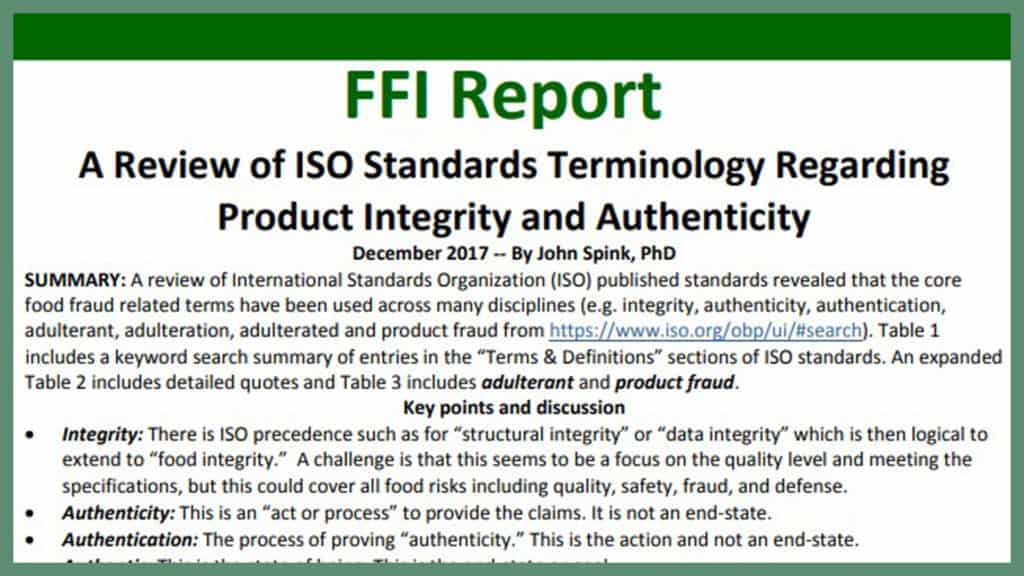This review of ISO standards is in support of several project definitions of Food Fraud and related terms. The ISO definitions are important to consider since they are already published, internationally recognized, led by government appointed representatives, and have already been through a rigorous, consensus-based development process.
The US government is represented and led by the American National Standards Institute (ANSI). From ANSI: “ANSI is the official U.S. representative to the International Organization for Standardization (ISO) and, via the U.S. National Committee, the International Electrotechnical Commission (IEC).”
The full MSU FFI report is available here: https://blog.foodfraudpreventionthinktank.com/wp-content/uploads/2021/02/FFIR-ISO-a-review-of-terminology-v9-formatted-FFPTT-v2-2018-2.pdf
From the Food Fraud Report:
SUMMARY: A review of International Standards Organization (ISO) published standards revealed that the core food fraud related terms have been used across many disciplines (e.g. integrity, authenticity, authentication, adulterant, adulteration, adulterated and product fraud from https://www.iso.org/obp/ui/#search). Table 1 includes a keyword search summary of entries in the “Terms & Definitions” sections of ISO standards. An expanded Table 2 includes detailed quotes and Table 3 includes adulterant and product fraud.
Key points and discussion
- Integrity: There is ISO precedence such as for “structural integrity” or “data integrity,” which is then logical to extend to “food integrity.” A challenge is that this seems to be a focus on the quality level and meeting the specifications, but this could cover all food risks including quality, safety, fraud, and defense.
- Authenticity: This is an “act or process” to provide the claims. It is not an end-state.
- Authentication: The process of proving “authenticity.” This is the action and not an end-state.
- Authentic: This is the state of being. This is the end-state or goal.
- Adulterant: Is something material (substance) intentionally added without permission.
- Adulteration: Is the act of an adulterant (substance) being added/included – past tense is “-ed.”
- Product Fraud: There is a definition and the scope includes food.
- Note: Product Fraud and Authentic claims are usually pertaining to intellectual property rights/counterfeiting.
ISO standard Definition Summaries
- Integrity: Summary – The statement of the unimpaired, unaltered, and unmodified condition of the item with safekeeping of the accuracy, completeness of the claim.
- Authentication: Summary – The act or process of proving something is genuine, assurance of the claimed identity such as origin or performance.
- Authenticity: Summary – Property of being of undisputed origin and not a copy, authenticated, and having the origin supported by unquestionable evidence.
- Authentic: Summary – Not false or imitation, genuine, having the apparent quality or character represented (expanding from ISO to Merriam-Webster’s Dictionary).
- Adulterant: Summary – Materials or substances intentionally added to the product for economic gain (or avoiding loss) or for intentional harm.
- Adulterate (-ion, -ed): Summary – Based on the word “adulterant,” “adulterated” is the past tense and “adulteration” is the action of adding or removing an adulterant. Note: this is in conflict with the FDA Food Drug & Cosmetics Act definition of “Adulterated Foods” that does not require an adulterant.
- Product Fraud: Summary – “Deception utilizing material goods for economic gain or avoiding a loss”
While defining terms may seem “academic,” without this effort there will be confusion and inefficiency. There will be many ways for stakeholders – individuals, companies, organizations, and governments – to participate in the development process. A first step is to create a review of current literature and publications such as our new report that is attached.

